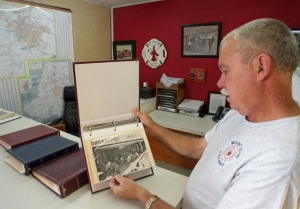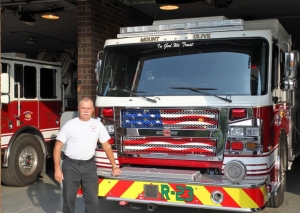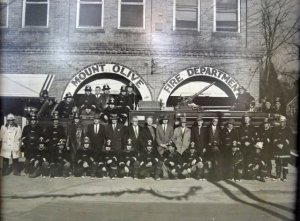Mount Olive moves closer to new fire station
By News-Argus Staff
Published in News on August 16, 2018 5:50 AM

News-Argus/STEVE HERRING
Mount Olive Fire Chief Greg Wiggins through scrapbooks of old fire department photos. The town has approved a feasibility study to find a suitable location for a new station.

News-Argus/STEVE HERRING
Wiggins stands in front of one of the department's newest engines. One of the reasons a new station is needed is because the size of the trucks has grown.

News-Argus/STEVE HERRING
This photo from 1959 shows firefighters in front of the three-story building whose bottom floor served as the fire station. Located on East Main Street, across from what is now the new Southern Bank corporate headquarters, the building was demolished years ago.
MOUNT OLIVE -- The first thing Fire Chief Greg Wiggins does when he enters the fire station is check for leaks.
"Over the map, over the door, the work bench, in the meeting room. It is almost like a sieve," he said.
The flat roof has been repaired over the years and it has helped, for a while at least, Wiggins said.
"A flat roof is a flat roof, and they are going to leak somewhere it appears," he said.
At their Aug. 6 board meeting, the Mount Olive town commissioners approved a $25,000 contract with Stewart Cooper Newell of Gastonia to conduct a feasibility study on a possible location for a new fire station.
The company is a leading expert in designing fire facilities in the country, Town Manager Charles Brown said.
The building has served the town well, but the department has outgrown it, Mayor Joe Scott said.
No timetable or budget has been discussed, but the department has put $5 million on its five-year capital improvement plan.
It could be less, but it's a good figure to start with, Wiggins said.
No matter the cost, town officials will to prioritize needs and determine how to finance them. They will also need the public's support for the project, he said.
Also to be decided will be what the town will do with the old station as well as the former rescue squad building where the county currently stations an ambulance.
There have been several thoughts on possible uses for the current fire station, including turning it into a police station or selling it to the highest bidder, Scott said.
The county plans to build its own EMS station near town and relocate the ambulance there.
Possible uses for the old rescue building include using it for the town's Parks and Recreation Department, Scott said.
"Also turning it into a life and science museum as it would be a good location for school-age kids to visit and have hands-on projects," he said.
"I'm excited at the progress we are making and the thoughtful discussions the town board is making for what is best for these buildings and the future growth of Mount Olive."
While the fire station's exterior looks fine, the building is showing its age, Wiggins said.
When it was constructed in 1966, the department's largest truck was an American LaFrance pumper that was about 27 feet long, seven foot wide and weighed about 29,000 pounds.
One engine currently housed inside the building is 32 feet long, eight feet wide and 42,000 pounds.
The tower truck is 47 feet long and weighs 80,000 pounds.
The floor, which was not deigned for such behemoths, has hairline cracks, Wiggins said.
The bay doors are 12-foot wide.
"So an 8-foot truck with a mirror off both sides sticking out another foot -- now it is 9 or 10 foot, leaving only a foot on either side when you are backing in," he said. "It is just extremely tight. We have hit mirrors and stuff on trucks getting them in and out."
Wiggins said he would like to see a new station with drive-through bays to eliminate having to back the trucks in.
"There are a lot of safety factors there," he said. "Anytime you are backing a truck of that size ... believe it or not, firefighters actually get backed over.
"We have things in place that are supposed to take care of that, but it is never safe backing one of these big trucks up."
The station was state-of-the art when it was built, Wiggins said.
However, trends in the fire service have dedicated the size of equipment and the station was just to built to house the larger trucks.
"We literally almost have trucks stacked on top of each other," Wiggins said.
"There is no room to move around in the bay area getting around equipment."
The station was not built with handicapped accessibility in mind, nor gender-specific restrooms, he said.
When the station was built, the majority of firefighters were men. Now, there are plenty of women in the fire service, Wiggins said.
"So there is a lot of catching up to do with this building," he said.
Turnout gear is stored in the bays, but that practice is now frowned on because of the fumes from the trucks settle on it, he said.
"Also, the particles that we bring back from a house fire are still on our gear and with the gear hanging on the wall, it contaminates the entire building," Wiggins.
The trend is to build separate rooms to store the gear where there are fans and ventilation to pull those particles out of it, he said.
"Cancer is a big deal in the fire service," Wiggins said. "Cancer and heart attacks are big killers in the entire country, but those numbers are even higher in the fire service.
"As matter of fact, cancer, there are four different cancers that are actually considered line-of-duty deaths in the fire service."
The station lacks a laundry room, much less the space for the proper type of washing machines and driers to clean the turnout gear.
Instead, the equipment is scrubbed down by hand at the station's wash bay where the trucks are washed.
But that is not the same as properly washing it in a washing machine, Wiggins said.
The department has budgeted for a washing machine, but simply has no place put it, Wiggins said.
Volunteers continue to do an outstanding job, but all volunteer departments are having trouble securing daytime help, Wiggins said.
"At some point in time, we will have people sleeping around the clock here," he said. "We don't have sleeping facilities here or anything to support that type of operation.
"I am not going to say that is going to happen in the next two years. I don't have that magic ball to know exactly when. I just know what I have seen happen in the last years, and it is going to migrate to that point ... that we will have to have more people on staff."
There are a limited number of suitable locations in the town, simply because of how fire districts are arranged, Wiggins said.
Most Wayne County departments serve a district within a 5-radius of the station.
Moving the station too far would affect the district lines for nearby departments such as Smith Capel to the west, Dudley to the north and Calypso to the south, he said.
Locating the station further east is the only direction where there would not be a problem with the district lines, Wiggins said.
Another factor is water distribution since the department's insurance rating is based on fire hydrants.
As such, water distribution is a significant factor in the rating which also directly impacts homeowners' insurance premiums, he said.
"If we move away and don't have the correct number of hydrants, it affects that rating," Wiggins said.
When all of that is considered, the station needs to remain in the general area of its current location, he said.
"You can ride through town and look, there are not many places to put a fire station," Wiggins said.
"That is one of the reasons for getting the feasibility study done. Those folks are experts in that field."
There has been speculation that the old National Guard Armory on Witherington Street could be used.
The building and property are owned by the town.
However, Wiggins said the town does not know if that is the correct spot. Also, as the building stands now, it could not be used as a fire station.
